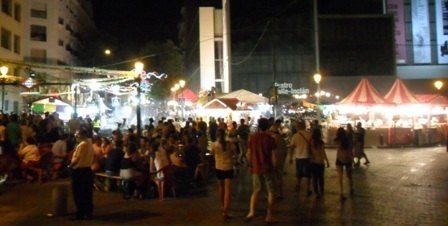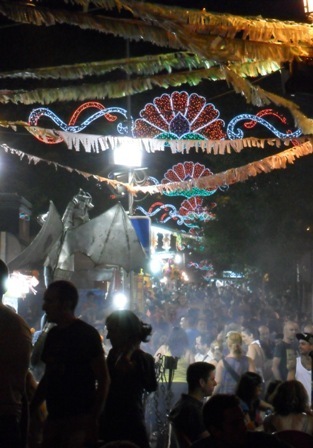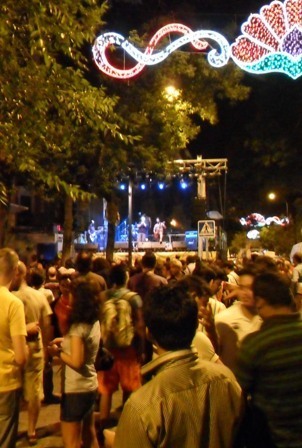Sue Burke's Blog, page 79
September 11, 2012
American vacation 2012 photos

After a slight delay (blame the day job), here are some photos from my vacation August 24 to September 9 in Milwaukee, Wisconsin, and Chicago, Illinois. Above, the view from my hotel room in Chicago at Chicon 7 in the Hyatt Regency. More photos here:
http://www.facebook.com/media/set/?set=a.10151090701588611.444578.537088610&type=1
— Sue Burke
August 23, 2012
Chicon / Worldcon schedule

Where to find me in Chicago:
Thursday, August 30, 3:00 to 4:30 p.m.
Daily Science Fiction book launch
Wrigley Room
Not Just Rockets and Robots, Daily Science Fiction Year One, official launch with author reading panel, discussion and signing. I have a story in that anthology
Friday, August 31, 3:00 to 4:30 p.m.
Broad Universe Rapid-Fire Reading
Grand Suite 3
Members of the Broad Universe organization read short excepts from current works. Reading: Brenda Cooper, Carol Berg, Cat Rambo, Catherine Asaro, Catherine Lundoff, Conni Covington, Deirdre, Gwynne Garfinkle, J. Kathleen Cheney, Kathryn Sullivan, Laurel Anne Hill, Lyda Morehouse, Mary Robinette Kowal, Roberta Gregory, Roberta Rogow, Sandra Ulbrich Almazan, Sue Burke. I’ll be reading from the end of Chapter 35 of Amadis of Gaul, the part where the knight Amadis and Princess Oriana finally consummate their forbidden love.
Sunday, September 2, 10:00 a.m. to 12:00 noon
Writers Workshop P
Grand Suite 4
Joan Slonczewski and Sue Burke, with three other participants. Previous sign-up was required and is now closed.
Sunday September 2, 6:00 to 7:30 p.m.
Face to Face Critique Writing Groups
Columbus CD
Discussion of the pro and cons of face to face writing groups and how working with your peers will help your writing. With David Boop, Gene Wolfe, J. Kathleen Cheney (moderator), Martha Wells, and Sue Burke.
I’ll also help staff the Broad Universe sales table — but you can go anytime to the table in the Dealer's Room, chat with fine female authors who would love to meet you, and buy their books.
— Sue Burke
August 21, 2012
My Hugo votes

Here are my votes for the Hugo Awards at Chicon, the 70th World Science Fiction Convention. I didn’t get to read all the novels, but I dutifully read all the shorter works of fiction, since Chicon was so kind as to give me electronic copies. Here are my votes and pitiless evaluations:
For Best Novella:
1. “The Man Who Ended History: A Documentary,” Ken Liu - does what SF should do.
2. “The Man Who Bridged the Mist,” Kij Johnson - true emotional depth.
3. “The Ice Owl,” Carolyn Ives Gilman - good, but with standard-issue evil religionists.
4. “Kiss Me Twice,” Mary Robinette Kowal - fun but lightweight.
5. “Countdown,” Mira Grant Orbit - clumsy prose.
6. “Silently and Very Fast,” Catherynne M. Valente - repeatedly and very slow.
For Best Novelette:
1. “What We Found,” Geoff Ryman - touching, and science with consequences.
2. “Fields of Gold,” Rachel Swirsky - odd and personal.
3. “Ray of Light,” Brad R. Torgersen - good but not outstanding.
4. “The Copenhagen Interpretation,” Paul Cornell - clever but cliché.
5. “Six Months, Three Days,” Charlie Jane Anders - inconsequential.
For Best Short Story:
1. “Movement,” Nancy Fulda - pure poetry.
2. “The Paper Menagerie,” Ken Liu - limited magic, no societal effect.
3. “The Cartographer Wasps and the Anarchist Bees,” E. Lily Yu - a bit shallow.
4. “Shadow War of the Night Dragons: Book One: The Dead City: Prologue,” John Scalzi - genuinely funny but not of Hugo stature.
5. “The Homecoming,” Mike Resnick - nattering stereotypes.
Feel free to tell me why I’m wrong, here or in Chicago.
— Sue Burke
August 15, 2012
Go Ahead — Write This Story: anytime, anywhere
Does a story have to be chronological? Of course not. And you knew that. It’s usually easier to tell a tale by the clock, but your story may vary. For example, your story may be not about what the journey through time but the emotional journey, which is never a straight line. Time is relative, too, even at non-light speeds. My friend Pat Bowne discussed that in her blog post here: http://raosyth.com/blog/?p=261 Meanwhile, if you want to tell a story that has its own time, here are a few ideas:
• This military SF story begins with the trial of an officer who had adopted alien tactics to win a war on an alien world, but was condemned as a lawless warlord at home.
• This is a story about a Lunar pioneer who finds archaeological evidence of previous inhabitants and starts to piece together the events that killed them.
• This is a subterficial story (look it up) in which a graphic novelist considers several possible story lines for an upcoming publication.
— Sue Burke
August 12, 2012
Summer in the city: Fiesta!
In Madrid, the August fiestas are underway: earlier this week, San Cayetano; then San Lorenzo; and from August 12 to 15, the big one, La Virgen de la Paloma. These are the traditional fiestas held in the oldest neighborhoods of the city. The official tourist website describes them here in English:
http://www.esmadrid.com/en/local-festivities
Last night, it was 95ºF at 10 p.m., and the San Lorenzo fiesta was gearing up with music, food, and drink in the Lavapiés neighborhood. My photos:

Plaza de Lavapiés.

Argumosa Street. The dragon advertises a stand selling grilled meats and fried foods.

The band Ynterceptor.
http://www.facebook.com/pages/Ynterceptor/108752449238742
— Sue Burke
August 8, 2012
Not our style
These days, we all tend to write a lot like Ernest Hemingway — which is not a bad thing: his style mimics spoken speech and shows more than it tells. It’s often called transparent.
I like that style, and I like Hemingway. Sometimes I drink in the same bars he did in Madrid hoping it will make me a better writer. But I don’t like the way his style seems to have become the only acceptable writing style in English today.
Other styles exist. I want to show a more embellished style that you can sometimes find in Spanish. What follows are extracts I have translated from the first story in Perlas para un collar [Pearls for a Necklace]. The book is a collection of thirty stories about Christian, Moorish, and Jewish women in medieval Spain. Half were written by historical novelist Ángeles de Irisarri and half by co-author Toti Martínez de Lezea — both highly considered Spanish writers. The story about Adosinda is by Irisarri.
Is this writing less vivid or less evocative than a transparent style? Or are the sentences too long, the style too “telly” and to “writerly”? Could this be published in English?
*****
[The story is set in Pravia, a town in Asturias, in northern Spain, in the year 790. The Moors invaded Spain in 711.]
When Adosinda returned to her hometown, Pravia, with her clothes in rags, dead-tired, drenched to the bones, and dragging her feet, she was surprised because the town’s inhabitants looked out of the windows of their houses and many of them, mostly women, came out to the street and converged to embrace her, their faces thanking her for this unexpected good news, and to offer her a swallow of wine, but above all to ask how she had escaped from the Saracens. This despite the pouring rain.
The girl was not surprised by the rain, since downpours were customary and proper to that region, but she was amazed that there were men, women, and children, all of them still with their heads on their shoulders, and that Pravia had not been burned down but instead remained as she had left it, or better said, as she had been made to leave it.
[She collapsed into a bed in the home of a widow. While she slept, the people of the town entered its dim, fortress-like church to profane the tomb of King Mauregato, dead for a few months. Earlier that year, he had ordered ten maidens from Pravia and a total of one hundred from his kingdom of Asturias to be given to the Moors, as he did every year so they would not attack. Since the Moorish invasion, his subjects had had good kings and bad kings, but none so bad as Mauregato.
Adosinda awoke the next day, asked about her mother, and learned she had died of a broken heart. She wept, then asked to go to her grave, and townswomen accompanied her to the church.]
The honorable women of Pravia were surprised, as they walked, by Adosinda’s festive ease as she gathered flowers, the most beautiful flowers along the roadside that, because it had stopped raining and the sun had come out, shone more lovely than ever, or so it seemed to the women, as did the bouquet she gathered, and, accompanied by the widow who took her by the arm as if she were her mentor, she knelt before the tomb of her good mother, withdrew into herself, prayed with fervor, then deposited the bouquet of flowers, and arose. But next, instead of leaving the church, she walked to the sepulcher of King Mauregato and did it again. She knelt and prayed and even laid a little flower or sprig or weed on the tombstone, whatever it was that she had kept in her hand, shocking all the women present and everyone who was absent when they found out what the girl had done.
[The women insisted that she tell what happened to her, since none of the other maidens had returned. Adosinda recounted, in spare words, how they had been roped together, marched away, and eventually raped by the soldiers. Days later, after more marching, when the captain tried to rape her again, he was repulsed by her menstrual blood. She was tied to a tree and left behind.
Eventually she freed herself and wandered, lost, praying to the two Saint James of the church of Pravia, until she arrived at the town, but during those months alone, she had found time to forgive everyone, including the king.
Two weeks later, after Adosinda had moved into the empty home of her mother, the priest called the townspeople together to say that a miracle had occurred.]
And everyone, including the girl, heard from the mouth of the sacristan that, Lord in Heaven, on the tomb of Adosinda’s mother, the bouquet she had left had not only not wilted, but in addition, beautiful violets had grown over the tomb and covered it completely, even though this was not the season for such flowers, since September was halfway through.... And one more thing, on Mauregato’s: nettles, which also covered it.
[She became known for the miracle, and soon people from all around flocked to see her.]
During her flight from the Moors and the trip back home, she had completely discarded the idea of marrying a good young man, having many children, forming a family, and being happy within what can be happiness in this world, both for what she had suffered, having been violently used, and because she realized that no man would want her as a wife after what had happened, so when people came to her to ask her to pray for their families, whether ancestors or successors — since many expectant women came to her — and because they gave her gifts and even considered her blessed by the two Saint James and soon called her “Saint,” that turn of events suited her, given that she had to make her living somehow, and this required no effort, for, after she had been taken from Pravia, she had done no other thing than to pray to the Baptist and the Evangelist to save her from the Saracens, which they had done.
*****
— Sue Burke
August 3, 2012
Member of SFWA
August 2, 2012
Going to Chicon? Want a pro critique?
Ten slots remain in the Writers Workshops at Chicon 7, the 70th World Science Fiction Convention. As the official website describes it:
“The Writers Workshops at Chicon 7 will be small-session workshops for either experienced or beginning writers based on manuscripts submitted in advance. These workshops will provide Chicon 7 members the opportunity to have their manuscripts evaluated by selling writers and industry professionals who enjoy helping them grow as writers. Many of these professionals have taught at residency workshops such as Clarion or in creative writing programs.
“Each session will ideally consist of submissions from three participants to be critiqued by the other participants and two to three professionals. The manuscripts will be circulated in advance to both the participants and the professionals. A workshop session lasting two hours will critique all three submissions, or provide a critique with directed instruction, at the discretion of the professionals in each session.”
Go to http://www.chicon.org/writers-workshops.php to ask for a slot.
See you there.
August 1, 2012
Guns: continual fear
My university major was political science, so of course I had to read Leviathan, by Thomas Hobbes. In this book, written in 1651, Hobbes attempted to formulate a theory of a nation-state, and he did so wracked, as he admits, by fear. In 1640, in fear of his life, he had fled his home in Great Britain to Paris and then Holland during the English Civil War.
His book angered many people for its ideas about how states are formed by social contracts and about how states can only rule if they hold sufficient power by consent of the governed — among other radical ideas for his time and ours. Leviathan is still admired as one of the most well-reasoned philosophic inquiries into politics.
You can hear a discussion about it at A Partially Examined Life: a philosophy broadcast and blog: http://www.partiallyexaminedlife.com/2009/06/07/episode-3-hobbess-leviathan-the-social-contract/
Chapter 13 (read it here) has earned the most fame, and I think it has some bearing on the situation in the United States and the use of firearms:
Hobbes begins the chapter by pointing out that all people are equal because they can all kill each other — and while he envisioned that someone physically weak might need to do it “by secret machination or by confederacy of others,” now firearms make each of us indisputably able anyone to kill at will.
He then says that since, inevitably, we will all sooner or later want something that someone else has or disagree with each other, we will be distrustful of each other because none of us can be safe from anyone else unless there is a powerful institution larger than ourselves, a common power which we all fear that can enforce peace. Without it, we cannot trust each other.
Without it, we will inevitably fight: to take each others’ possessions, to defend our possessions, or over differing opinions, such as religion or politics. So, without that common power forcing us to behave peacefully, we are in a constant state of war with one another. In a total war of all against all, we can have no industry since we cannot be sure we can reap its profits, no business because we cannot trust each other, no arts, no society, but only “continual fear, and danger of violent death; and the life of man, solitary, poor, nasty, brutish, and short.”
And yet, he said, people want peace so they can have comfortable lives and the industry and business to create comfort. From this desire, people can be drawn into agreement to create a social contract for a peaceful civil society.
So much for Hobbes. And where is the US in this theory of government? Behind right-to-carry and “stand your ground” laws and increased arms sales, I see the perception that there is, here and now, a war of all against all — perhaps low-level, but very real. There is a perceived need to have a gun to be safe, even in a restaurant or movie theater, and certainly at home against intruders. The government is not perceived to be sufficiently powerful or competent to keep us safe, which Hobbes would consider a failed government.
Fear, and danger of violent death as a constant. No trust. And lives made smaller and poorer. Fights among citizens keep growing more vicious not just over possessions, but over opinions.
And yet, the vast majority of gunholders want peace and see no other way to secure it than by increasing their ability to kill at will, but I think this is a social contract in favor of greater war, not in favor of peace.
If Hobbes is right, this war does not need to continue. To stop it would take a willingness to create a social contract that involves everyone agreeing to give up some freedom to own and use lethal power at will — perhaps limiting the firepower of guns, perhaps requiring specific safety training for all gun owners, perhaps limiting the types of permissible munition, perhaps requiring insurance for gun owners the same way that cars must be insured. There are many other ideas that might begin to ratchet down the level of warfare.
These can be a hard concessions to make, which is one reason why Leviathan is a long book: what to give up, when, how, and the “unalienable rights” (in Hobbes’ words; the Founding Fathers had read him carefully) that cannot be agreed away.
Are we Americans willing to begin that long, hard process of negotiation to move away from a state of war and toward peace?
— Sue Burke
July 25, 2012
Go Ahead — Write This Story: Ideas, not dumps
Science fiction is "the fiction of ideas," neat ideas that evoke a sense of wonder — but avoid infodumps, evil expository lumps that merely explain the idea and stop the plot dead. Keep your stories focused characters trying to solve a conflict involving the neat idea. A few carefully chosen details or a scene that shows the idea at work might be enough to create a wonderful universe for your readers. Never stop telling the story. If you need an idea, here's one, and a few more are scattered throughout this ‘zine.
• This is a shocking story about the first marriages between humans and non-terrestrials in the U.S., which federal law promptly declares illegal because of beliefs that the humans have been coerced.
• This is a first contact story that begins when the Moon suddenly disappears, taking with it Tycho Colony.
• This is a story about a pregnant veterinarian in Chicago who realizes that something has caused animal babies to mutate — and it might have affected humans.
— Sue Burke



